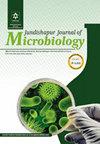肠内万古霉素耐药肠球菌中氨基糖苷类耐药基因及毒力因子的患病率
IF 0.5
4区 医学
Q4 MICROBIOLOGY
引用次数: 1
摘要
背景:近年来,耐万古霉素肠球菌(VRE)被公认为医院内病原体,其重要性日益增加。这些细菌经常从重症监护室(ICU)的病人身上分离出来。不同的抗生素耐药性和毒力决定因素增强了肠球菌的致病性。目的:本研究旨在评估ICU患者肠道VRE分离株中编码抗生素耐药性和毒力因子的基因的流行率。方法:本研究共调查23例VRE。用E检验法检测了9种抗菌剂的最低抑菌浓度(MIC)。使用多重PCR检测编码万古霉素抗性(vanABCDMN)、氨基糖苷类修饰酶(aac(6')-Ie-aph(2“)-Ia、aph(2')-Ib、aph“-Ic、aph”-Id、aph 3’IIIa、ant 3’-Ia、ant 4’-Ia和ant 6’-Ia)的基因,以及各种毒力因子(ace/acm、asa1、cylA、efaA、esp、gelE和hyl)的基因。结果:所检测的VRE的种类分布如下:9种卡氏肠球菌、7种没食子酸肠球菌和7种粪肠球菌。在所有粪大肠杆菌中都发现了vanA基因,其中6个粪大肠杆菌观察到了经典的vanA表型。万古霉素(vanC)表型与鸡E.gallinarum中vanC1基因和卡塞利夫E.casselflavus分离株中vanC2基因的存在有关。aac(6')-Ie-aph(2“)-Ia基因编码高水平庆大霉素耐药性(HLGR)在所研究的VRE中。所有粪便大肠杆菌的acm和esp均呈阳性,而在2例vanC肠球菌中检测到acm与esp或hyl的联合作用。结论:根据研究结果,在所测试的VRE中,糖肽抗性的表型和基因型之间存在相关性。由于aac(6')-Ie-aph(2“)-Ia的存在,HLGR在粪便大肠杆菌中更为普遍。与所研究的携带vanC的肠球菌相比,vanA分离株中毒力决定因素的流行率更高。本文章由计算机程序翻译,如有差异,请以英文原文为准。
Prevalence of Genes Encoding Resistance to Aminoglycosides and Virulence Factors Among Intestinal Vancomycin-Resistant Enterococci
Background: Vancomycin-resistant enterococci (VRE) are recognized as nosocomial pathogens with increased importance in recent years. These bacteria are frequently isolated from patients admitted to intensive care units (ICUs). Enterococcal pathogenicity is enhanced by different antibiotic resistance and virulence determinants. Objectives: The present study aimed to assess the prevalence of genes encoding resistance to antibiotics and virulence factors in intestinal VRE isolates from ICU patients. Methods: In this study, 23 VREs were investigated. Minimum inhibitory concentrations (MICs) to nine antimicrobial agents were examined using E-test. Genes encoding vancomycin resistance (vanABCDMN), aminoglycoside-modifying enzymes (aac(6')-Ie-aph(2")-Ia, aph(2")-Ib, aph(2")-Ic, aph(2")-Id, aph(3')-IIIa, ant(3')-Ia, ant(4')-Ia, ant(6')-Ia), together with genes for various virulence factor (ace/acm, asa1, cylA, efaA, esp, gelE and hyl), were detected using multiplex PCR. Results: The species distribution of the tested VRE was as follows: Nine Enterococcus casseliflavus, seven E. gallinarum, and seven E. faecium. The vanA gene was found in all E. faecium, in six of which the classical VanA phenotype was observed. The vancomycin (vanC) phenotype was associated with the presence of vanC1 gene in E. gallinarum and the vanC2 gene in E. casseliflavus isolates. The aac(6')-Ie-aph(2")-Ia gene was encoding high-level gentamicin resistance (HLGR) in the studied VRE. All E. faecium were positive for acm and esp, while acm in combination with esp or hyl was detected in 2 vanC enterococci. Conclusions: According to the findings, there was a correlation between the phenotype and the genotype of glycopeptide resistance in the tested VRE. HLGR was more prevalent in E. faecium because of the presence of aac(6')-Ie-aph(2")-Ia. The higher prevalence of virulence determinants was confirmed in vanA isolates compared to the studied vanC-carrying enterococci.
求助全文
通过发布文献求助,成功后即可免费获取论文全文。
去求助
来源期刊

Jundishapur Journal of Microbiology
MICROBIOLOGY-
CiteScore
1.30
自引率
0.00%
发文量
56
审稿时长
6-12 weeks
期刊介绍:
Jundishapur Journal of Microbiology, (JJM) is the official scientific Monthly publication of Ahvaz Jundishapur University of Medical Sciences. JJM is dedicated to the publication of manuscripts on topics concerning all aspects of microbiology. The topics include medical, veterinary and environmental microbiology, molecular investigations and infectious diseases. Aspects of immunology and epidemiology of infectious diseases are also considered.
 求助内容:
求助内容: 应助结果提醒方式:
应助结果提醒方式:


